Bangkok: After 30-year absence, tastes remain the same in Sodom & Gomorrah East
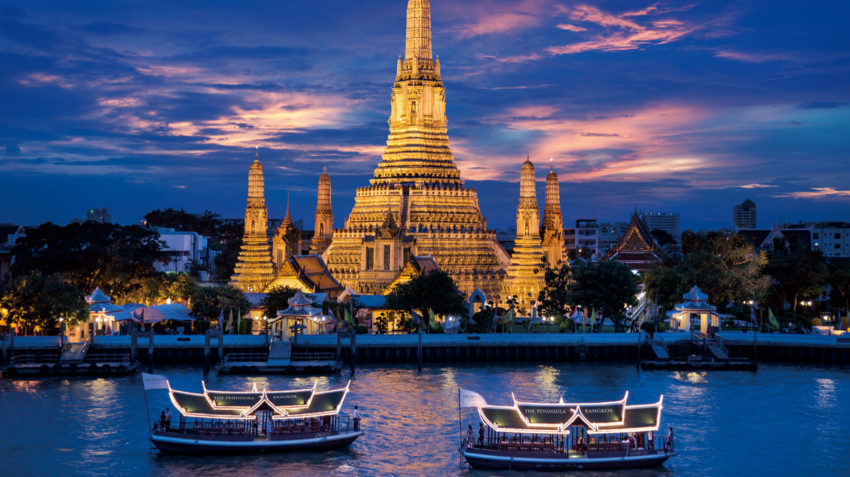
“One night in Bangkok makes the hard man humble.
Not much between despair and ecstasy.
One night in Bangkok makes the tough guys tumble.
Can’t be too careful with your company.
I can feel the devil walking next to me.”
— “One Night in Bangkok” by Murray Head
BANGKOK, Thailand — Welcome to the land that morality forgot. Bangkok is where visions are blurred, not only through the haze of too many Singha beers but the vast tolerance of a Buddhist culture and tourist industry run amok. It’s where a he is a she and a she can do things I didn’t learn on the streets of Eugene, Ore.
When I started traveling in 1978, Bangkok became my gateway to the extremes of Asia travel. It guided me through an education that hardened me on my way to visit 100 countries. It nurtured me while racked with a vicious case of typhoid that cost me 20 pounds in eight days. It’s where I smoked Thai stick in a bamboo home over a pond and hallucinated about snakes wrapping around my ankles until my Thai host said, “You’re not hallucinating. They’re real.” Where else could I watch a woman fire darts out of her vagina and pop balloons held by men ringing her stage then have her sit on my lap and ask to come home with me?
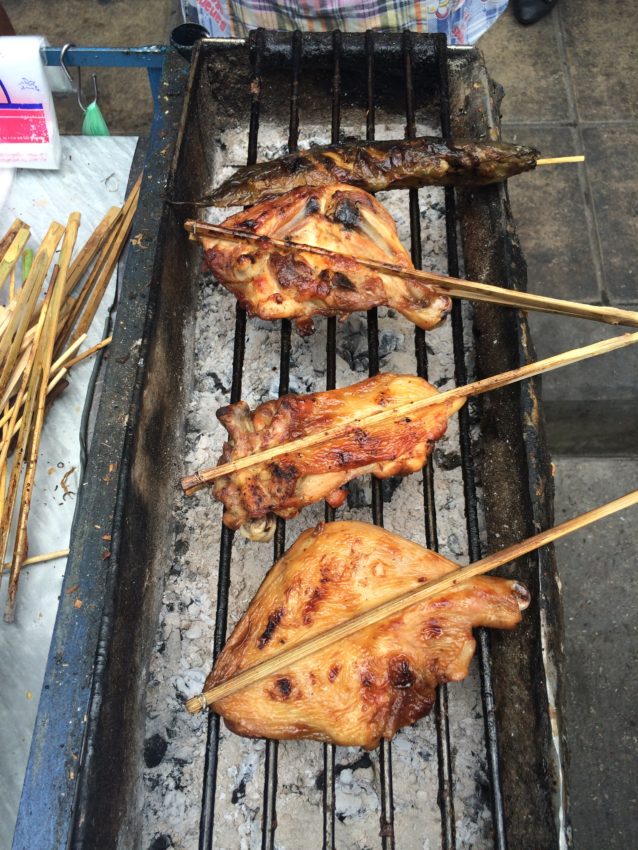
But it’s also where the perpetual sweet smell of fish sauce and chilies led me around every corner looking for the next cheap, delicious street stall. It’s where the warm air blew across my face as I darted around the streets in tuk-tuks, Thailand’s charming little three-wheeled, open-aired taxis. It’s where I learned the bad rap given the beautiful Thai women, the vast majority of whom are among the most advanced in South Asia.
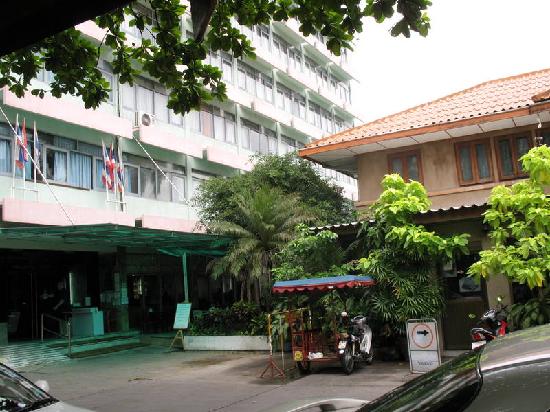
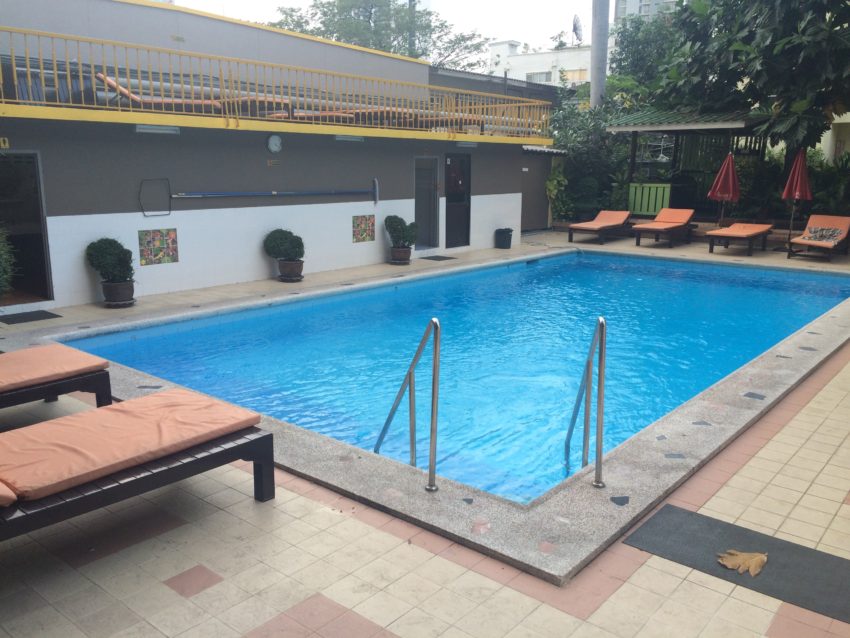
It is here where I returned last month for the first time in 30 years. Bangkok wasn’t a destination. It was a base to come and go sandwiched around a three-week journey through Laos. Being gone from Bangkok for so long, I wanted some familiarity. So I booked two stays at the ol’ Malaysia Hotel. I still call the Malaysia my old stomping grounds. I spent so much time here in three previous visits, I should’ve received enough points to get a free week’s stay. Or, at least, a free lap dance. As it is, you don’t really need points at the Malaysia. It has always been one of the best bargains in Thailand. I’m paying only $28 a night. That’s for a great room and swimming pool in Lumphini, the neighborhood with Bangkok’s biggest park and most expensive bar. So if you want to save your money for larcenously priced drinks to impress a lady, the Malaysia is the place for you.
In my past visits to the Malaysia, the way you impressed a lady was buy her breakfast the next morning. The Malaysia’s whory reputation was known to every male with a passport and a drop of testosterone. It became famous in the ‘60s as the R&R destination for battle-fatigued and horny American soldiers. By the time I arrived the first time in 1978, it had become nothing less than a pseudo brothel, a hangout for hookers, hippies, backpackers, short-term workers and the occasional world-weary expat. At 22 years old, I had to cut through the hookers in the lobby like the entrance of an NFL stadium just to reach the elevator. I remember one time a young, lithe thing in stilettos was dry humping an Aussie’s leg as they entered the elevator. I stood back looking, expressionless from sexual overload common in Bangkok. The woman rested her head on the man’s shoulder, winked at me and licked her bright red lips.
The Malaysia has changed quite a bit in 30 years. The swimming pool, complete with a balcony deck where a gay Thai tried chatting me up once in ‘79, is still the same. Also left over is the sign on the elevator that no one ever read, saying, “Anyone not a guest must register at the front desk before entering elevator.”
But I’m writing this outside next to a koi pond where a squadron of big, fat white fish float motionless under a big fern. The bar has moved to the other side of the lobby and a big screen TV is showing CNN’s preview of the Six Nations Rugby tournament. Some old men, looking tired and bored, sit over half-filled orange juice glasses and coffee rapidly cooling in the pleasant winter morning. I can’t help but think of what Thai teenager they violated last night. Bangkok does that to you. I have become a sexual cynic. As it turns out, I was right. Later in the lobby, I heard too older men, one New Zealander and the other Aussie, talk about their experiences with Asian men on Tinder. They were later joined by a chubby, pale American man in his 50s with his Thai boyfriend in his ’30s.
The Malaysia has turned into, at least those days, as a gathering place for old queens.
The neighborhood changed, too. In ‘78, I went around the corner to a courtyard of cheap open-air restaurants. I’d sit with Aussies and Dutch and eat passable French toast for $1. I’d overhear tales of their “cure.” That was the catch-all word for post-sexual trysts in Bangkok. This was pre-AIDS 1978. Nearly every corner in Lumphini had a VD clinic on it. The “cure” was sticking a needle down your dick. Even at 22, underloved and oversexed, I didn’t care how beautiful a woman was. I didn’t want sex if the price was getting a needle stuck down my dick. (While writing that sentence, I just subconsciously crossed my legs and bent over.)
Today, the neighborhood has gone to a higher-end tourist. Down the street is an Ibis hotel and some ugly high-rise hotels. Across the street is a 7-Eleven, one of 2,700 that have sprouted in Bangkok. I didn’t recognize the place. The Thailand I remember was a Thailand of the streets. Everything was outdoors: eating, drinking, sometimes shtoinking. Now the gross over saturation of tourism I saw in the ‘70s, 40 years later, has vomited up a sick concrete jungle.
However, the smell of Bangkok hasn’t changed. The aromas of tangy fish sauce, firecracker chilies and grilled fish swirled in the air as soon as I left Bangkok’s sparkling Suvarnabhumi Airport, built only 11 years ago. In fact, all of Bangkok’s public transportation has transformed over the last 30 years. When I first arrived at 22 on a trip around the world, I walked out of grimy, gray, Don Muang Airport and piled into a public bus so packed I had to sit on one end of my duffel bag, like a golf fan sitting on one of those stick-type seats. When I left Suvarnabhumi, I took the Airport Link train to the MRT, Bangkok’s subway, and took it to Lumphini station. Cost for two train tickets? Two dollars.
I emerged from the MRT with an Aussie on his first overseas experience. He’s 50. This I found odd. Aussies are born with wanderlust. They do their first “OE (Overseas Experience),” or “walkabout,” at 22 or 18. They’re the most traveled people in the world. No wonder their xenophobia is lower. But this guy was on his first journey.
“I had two jobs, worked my whole life, wife, two kids,” he said, almost exhaling in relief. I didn’t have to ask what happened to the marriage. He arrived in Bangkok two days earlier and had the same over-the-top exuberance I had when I first arrived in Asia. He was hopping around like a puppy.
I clued him in on some key Thai words I still remember from 30 years ago: “Korp kun cow” (Thank you), “Sawadee” (Hello) and “I don’t pay” (My jai.).
This really isn’t fair to Thai women. An estimated 2 million Thais work in the sex industry. That’s both women, men and men pretending to be women. A couple in the countryside has an attractive daughter and they send her to Bangkok to send money back home. For some reason, there’s a particularly fertile breeding ground of beautiful young girls in northeast Thailand.
However, the Thai women who aren’t hookers, the vast, VAST majority, are great, modernized women. When I was here in the ‘70s, there were more female college students than men. According to the Harvard International Review, last year 80 percent of the total employment of Thailand’s 10 largest export industries were women. Rural Thai women have always been the central bread winners and have owned land since the decree of King Rama V (1853-1910). Last year Thai women had the fifth most PhDs compared to men (57 percent) in the world and made up 51 percent of science researchers. I have often talked to Thai women business owners. During a short stint with The Associated Press in Bangkok, I worked with a female journalist.
And they’re not promiscuous. I dated a couple Thai women in the ‘70s and they adhere to Buddhist morals. In Buddhism, premarital sex is tolerated but not condemned. The average Thai woman wants the same thing any other woman in the world wants first.
Respect.
They did have an odd dating ritual. After I met my translator for a beer after covering the Asian Games, the tuk-tuk driver dropped me off at the Malaysia. I didn’t ask her in. Instead, she handed me a piece of paper. I noticed that she was writing on it before we left. “It’s a Thai custom to write something about a person when you first meet,” she said sweetly.
In the lobby I read it and wasn’t sure if I was more impressed with her sharp observations or command of the English language when I read, “You are a truly evil troll and really only worthy of extermination.” (I made up the line but not the custom.)
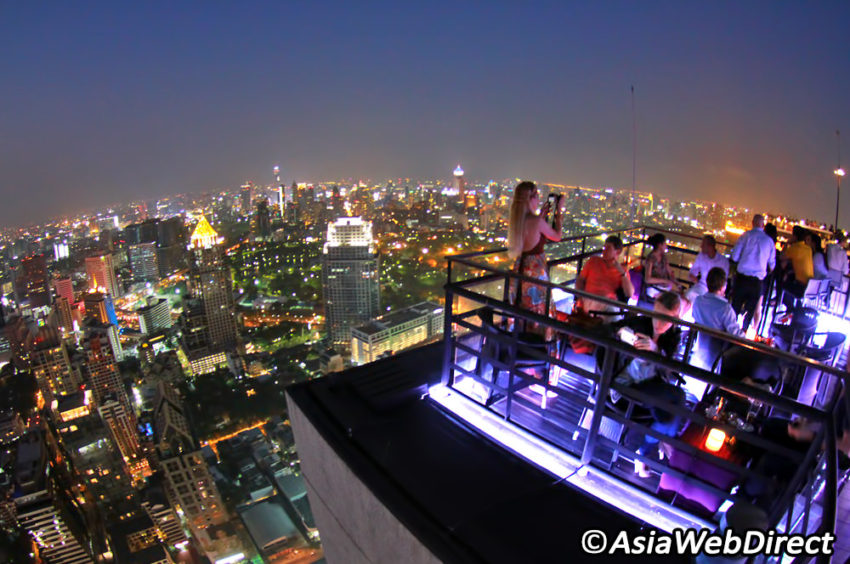
The beauty of returning to destinations is you get to peel away another layer of culture. I spent a month in Thailand in 1978, a week in ’79, a smattering of days in ’87. I’ve seen the reclining Buddha and the Grand Palace. I wanted to see the new, modern Bangkok. So I went to the Moon Bar. It advertises itself as having the best view in the city and I wanted a place to hang out before diving into Bangkok’s culinary delights.
Getting there was an adventure. In previous trips, the mode of city transport was the tuk-tuk, these motorized trishaws that cost maybe 50 cents or a buck to go a kilometer or two. They have evolved into a blatant tourist trap. For the tourists who want the novelty, not to mention selfie, of the tuk-tuk experience, they charge more than an air-conditioned taxi and negotiate prices as if they’re down to their last dollar.. Instead, I got directed to a guy in a gray and orange vest leaning against his motorcycle. I negotiated his price from 40 baht ($1.15) to 30 (90 cents) and we whizzed around cars, my knee barely missing their side mirrors. We went down modern, wide Soi 1 to the Banyan Tree Hotel. It was right out of Lower Manhattan, a 63-story skyscraper with doormen, guards and a fountain at the entrance. Two elevators later, I was on the top floor weaving my way through candlelit dinner tables to the elevated bar. It was a square, back-lit bar with a mind-boggling 360-view of modern Bangkok. This isn’t your father’s, or my Bangkok. Skyscrapers stuck up haphazardly all over downtown. The architecture is something out of an acid trip. One skyscraper even taller than the Banyan Tree zigzagged up toward the sky with uneven sides. It looked like a Lego structure missing some Legos. Another skyscraper had a swirling outer wall like giant snake.
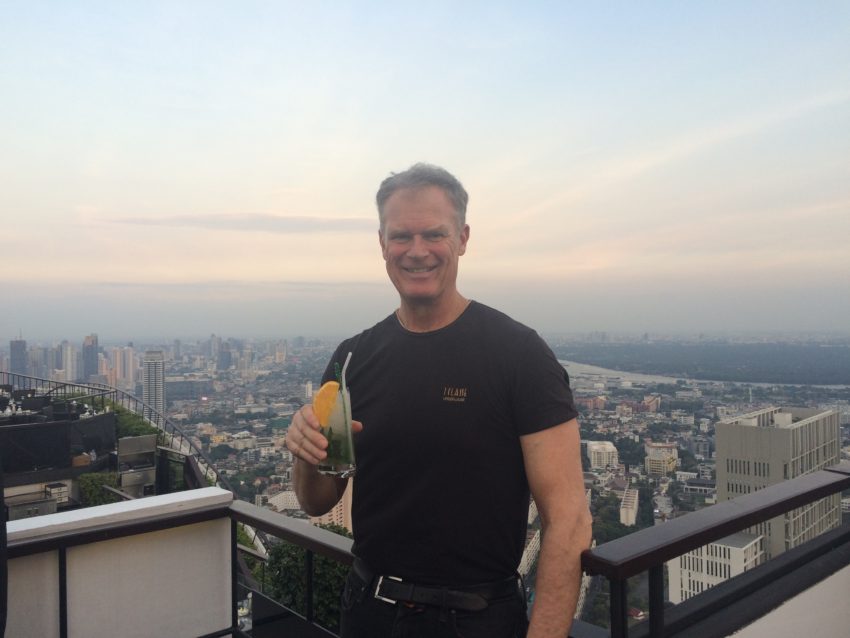
But I don’t know if I was more blown away by the view or the prices. One of the cute, young cocktail waitresses with a blouse off one shoulder handed me a drink menu. The cheapest cocktail was 580 baht ($16). I turned to a young American blonde and said, “I don’t know if I’m secure enough in my manhood to order a Lychee Ginger Smack.”
“Sure you are,” she said. “I’ll order it and slide it over to you.”
I went with the Moon Bar Mojito, not only because it sounded a little more manly but also it was the cheapest drink on the menu. It was Absolut Mandarin, Pampero rum, vanilla, mango, mint and lime all of which cancelled each other out to where I was basically drinking slightly flavored crushed ice. It was a $16 Slurpee.
The blonde was one of three San Diego women who had been all over Southeast Asia for three weeks. This was their last night in Bangkok and were splurging at the Banyan Tree. They were drinking a bottle of Cabernet Sauvignon which the waiter poured with a thick, white napkin wrapped around it. Price: 23,000 baht ($65). When I first visited Bangkok, I lived on $5 a day. Think about it. We talked about the usual traveler banter. Best island: Ko Ngai. Best food: Vietnam. Nicest people: Thailand. We were joined by a skinny kid in his 20s who’d traveled around Thailand alone between jobs.
“I’m tired of traveling alone,” he said. I wanted to say, “You’d better get used to it. Southeast Asia isn’t for everyone.” It isn’t. Not everything is the Moon Bar. It’s hot, real crowded, chaotic. Bangkok has no visible street signs.
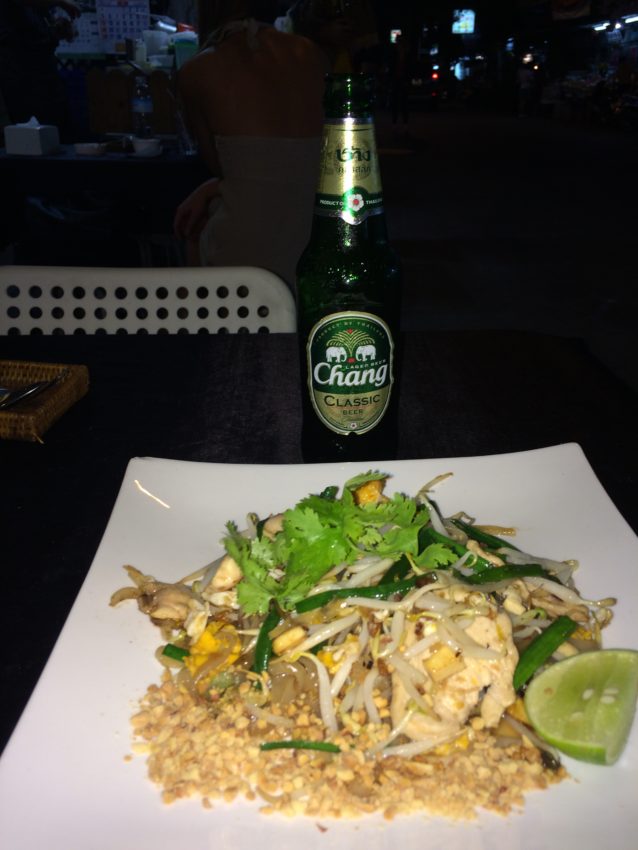
However, like Rome, when Bangkok gives you a headache and you’re exhausted and frustrated, there’s always dinner to look forward to. A guy on InterNations Bangkok told me to go to a restaurant called Uncle John. The name alone told me to stay away but locals know where to find two things: women and food. Uncle John is on a smaller street off Rama IV and was the typical rudimentary Thai restaurant. Crude white plastic chairs were set up outside with a cheap, dirty yellow sign reading “UNCLE JOHN: Thai and French cuisine.” A tired middle-aged woman in an unfortunate short haircut stood behind a busy desk where she poured multi-hued syrup onto shaved ice for locals seeking dessert. The place wasn’t crowded. I almost got up and walked across the street to the street stall with a sign in Thai and the place packed with locals. But they were all eating soup, a food I can not stomach in the tropics.
I went with my usual habit for a first meal: the national dish. I ordered the pad thai which was better than anything I had in the States: long, flat noodles with big, fat chunks of chicken and bits of green onion and ringed with peanuts. That and an ice-cold Chang beer was all of $7.

Uncle John is a Michelin star restaurant compared to where I went the next night. Bangkok’s Chinatown may be the biggest in Asia outside China. I tried eating in one of Bangkok’s plethora of Western shopping malls but I couldn’t handle eating next to an escalator and on a Pokemon placemat. I returned to the heart of where locals go: Chinatown. It’s smack dab in the middle of the city, not far from my hotel. The main drag of Chakrawat Road is lit up like the Las Vegas Strip with vertical neon signs flashing giant Chinese characters. It may be the brightest street in Southeast Asia. The sidewalk was lined chock-a-block with cheap, hole-in-the-wall restaurants. The tables were covered with large iron-frying surfaces sizzling with crayfish, chicken and whole fresh fish, their eyes, still open, staring off at the diners packing the sidewalk. Bangkok’s air may be dirty but the air in Chinatown may be the most delicious in Asia. Fish sauce. Chilies. Grilled chicken. It all blended together to make me crave wherever my nose took me. I wasn’t hungry when I arrived. One block out of the taxi I was starving.
I’m here during Chinese New Year and Thais packed nearly every stall. At one on the corner, a line snaked around the side of dozens of tables filled by sweating, devouring humans. Occasionally I’d see the white face of a bedraggled backpacker or some savvy old Asian hands going native.
I skirted my way up a side street, each one I passed becoming a little less crowded. By the time I reached the corner, I was hopelessly lost. The streets in this part of Chinatown have no signs. The main streets are in two languages, neither of them English. I asked a man selling fruit from darkened stalls for a restaurant called Nai Mong Hoi Thod. Like many Thai place names, it sounds like a cat that gets its paw stuck in a lawnmower. But down three stores there it was, home to reputedly the best fried oysters and mussels in Bangkok. I took a plastic chair outside and a 30ish guy with bushy black hair handed me a grease-soaked, plastic covered menu. He said he’s out of mussels but nodded when I pointed to the fried oysters in oyster sauce. I thought, I’d better like oysters.
Just then an old Thai man at the table next to me saw me writing in my notebook.
“You a food critic?” he asked in remarkable English.
“I write about food,” I said. “Damn. You caught me. Usually I read a newspaper while I’m taking notes. I can’t really get away with that with a Thai newspaper. Good food here?”
He waved his hand back and forth.
“Overrated,” he said. “I know two places better …”
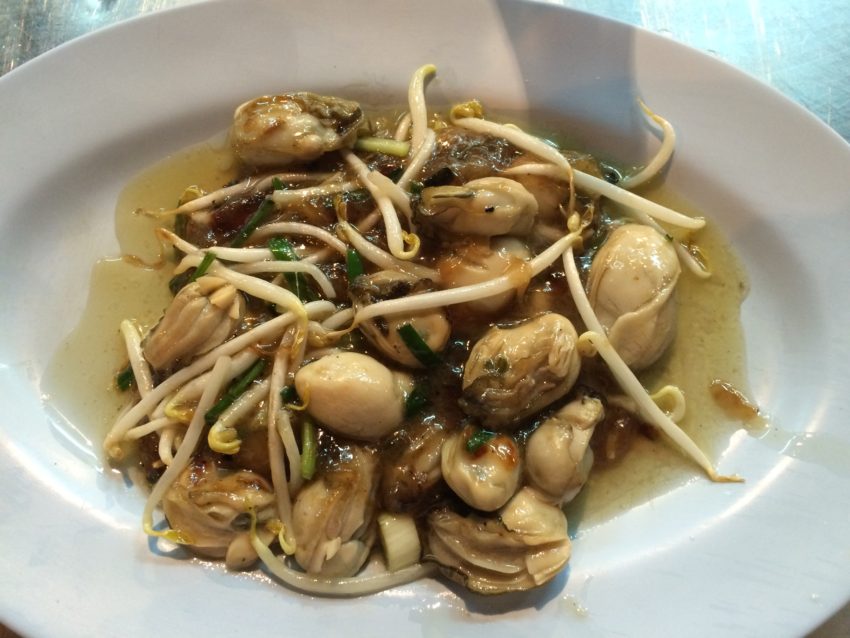
He went on to give me directions that would confuse Indiana Jones. Also, he was full of shit. The fried oysters were great. They were little greasy, gray balls in a brownish-gray glue that looked absolutely disgusting, like polyps from a cancer dying cancer patient. But I’ve never had a more flavorful oyster. And the sauce gave it a thick gravy that exploded in my mouth.
Unfortunately, its price of 150 baht ($4) also reflected the size. I was still hungry when I squeezed my way through the mob trying to find a seat, any seat, in the mass of sweating humanity. It’s been pleasantly cool in Bangkok. About 80 and dry. Here in Chinatown at night with all the flavors and steam filling the air, it felt like the inside of a pressure cooker. Not finding a single seat, I wandered up a side street and saw an old man hawking whole slabs of gray crabs tied with string. A huge iron barrel held clams. A young cook was grilling crayfish. I asked the price for the clams.

“One hundred fifty,” the old man said.
“What? One fifty for one?” I said. What else could it be?
“No. 150” and he formed a circle with his forefinger. Four dollars for a whole plate of clams.
I took a seat in the back and sweated like a pig heading to slaughter. I drained half the liter bottle of Chang beer in one gulp until the fans mercifully turned on. The clams were small but good. However, about a third of them were steamed shut. My greasy fingers couldn’t get purchase trying to pry them open with the fat forks. They were clams basically telling me, “Fuck you!” Then again, what should I expect from a seafood restaurant that uses a roll of toilet paper for napkins?
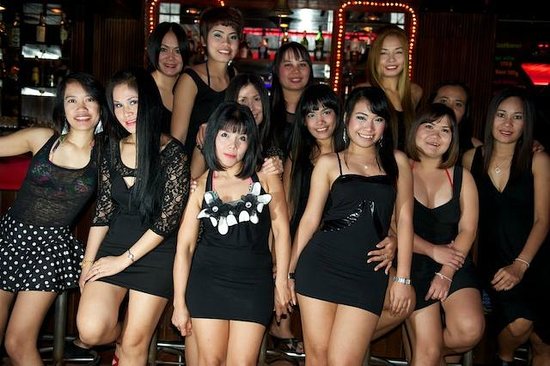
You see, Thailand has so much to offer than sex. (I can’t believe I just wrote that sentence.) I’ve read that Patpong, the neighborhood of more flying testosterone and sperm than any in Asia, has devolved into somewhat of a sexual theme park. The girly bars are still there but it’s more of a place to view its seedy past than lay any seed. The last time I was there, a billboard outside a bar called Mary Queen of Scots listed the following: “Dart throw. Ping pong toss. Signatures. Bottle opener.” Use your imagination. Yes, it was all true.
I had no interest in returning to a scene that made me flaccid at 22. I took another local’s advice and took a taxi clear across town to Zak’s, which he billed as a great place to meet locals and expats alike. It was along Sua 17 off Ploenchit Road where the apartment buildings grew bigger and nicer. This is definitely where the Thai white-collar class lives. Soi 17 was lined with upscale bars, all with modern signs and big glass windows and soft lighting. Zak’s, more of a restaurant, was dead, forcing me next door to the culture-killing establishment, curiously named the German Beer Bar. At least I knew Thais ran the thing. Cute waitresses in Germany’s red, yellow and black colors skirted around with big pint mugs of beer. It was happy hour until 1:30 a.m. and I sat between a young couple and two young Swedes.
Gary, the guy in the couple, was a white Hong Kong native. He spoke fluent Cantonese and Mandarin and English with a slight British accent. He chatted with me in English and his Chinese girlfriend in a smattering mishmash of English and Cantonese. He misses Hong Kong. The UK’s relinquishment of it to China in 1999 didn’t change it politically. It’s a free democracy with a free press. Unfortunately, Gary has an export business and is stuck in some small town four hours north of Shanghai. They watch movies at home for fun. He was clearly clinging to the happiness that his lovely, curvy Chinese girlfriend gave him. Of course, I had to ask.
“What does China think of Donald Trump?”
“Ha! I was afraid to bring him up,” he said. “They hate him. They’re worried. He’s going to make it worse for both countries.”
Hey, maybe Trump will bring both Chinese and American people together. Maybe we’ll all celebrate the Chinese New Year in a joint effort to erase that motherfucker from the face of the earth. We toasted to the death of Trump, which I repeated with the two Swedes who said, “Only 2 percent of Sweden likes him.”
“Two percent?” I exclaimed. “WHAT 2 percent?”
They were 19 and on one of Sweden’s many government-sponsored holidays. They had traveled around Cambodia and the Thai islands, drinking a lot of beer and oggling at the flying vaginas all over Thailand. I asked one of them, a skinny kid in a tanktop with hair the color of straw, about what he thinks of the supermarket displays of sex.
“I’m too inexperienced,” he said. He then went on to describe a lady boy show where a boy dressed like a woman gyrated on stage for customers obviously wondering about the vagueness of man.
The other Swede, a tall, handsome, rakish kid with two cheap island necklaces, said, “I’m all for expressing your sexuality. But when you become a tourist attraction …”
The novelty has long since worn off on me. I no longer see if Thai women make eye contact with me. I don’t spend boring time alone trying to figure out if a woman is a woman or a man. Across the bar sat two women, one with dangling diamond earrings and gorgeous, thick, black hair and the eyes of a doe. She was also skinny as a rake. She was staring at me. Her friend had the high cheekbones that transvestites just can not hide, no matter how much surgery they have. I asked the Swede to weigh in.
“Why don’t you go find out?” he asked.
“I don’t WANT to find out,” I said.
At the corner of the bar was a late middle-aged man, with graying hair and bulky stomach. Resting on his shoulder, maybe asleep, was a reasonably attractive Thai woman no more than 20. He tried to talk to her but her English was strictly rudimentary, “blowjob talk” as expats call it here. He. Talked. Like. This. To her. She looked bored with him and only gave him the ubiquitous smile that basically said, “Hurry up and pay me.”
Starving as the bar closed at 1:30, I went across the street to an all-night diner. Over some fantastic chicken fried rice in chili paste, I saw four couples, all old Western men with young, lithe Thai women, each one more bored than the last. No affection. No connection. No communication. The women were eye candy and an orgasm at the end of the night. The men were a way to get them to the next day.
On the bright side, Thailand is the one place in the world where geeky, ugly Western guys can get a pretty girlfriend. It’s also where pretty women can get out of poverty real fast and easy. It’s a trade off that has less communication than animals in the Serengeti.
As I took a long tuk-tuk ride back with a driver who had no clue where my hotel was, I thought of my Marina back in Rome. I don’t remember missing a woman more than I did then.


March 13, 2017 @ 3:33 pm
Do the oysters and clams grow locally in salt water? Love bangkok, too
August 8, 2018 @ 2:39 am
great blog. I personally like Thailand and have been there many times (lost count). It is really mix culture between budhism and the sex industry where many old man with young thai girl. But the food are great minus the chilli:) My stomach can not handle the hot Thai chili for the first week, but after that it is okay, ha..ha..
August 8, 2018 @ 4:06 am
Thanks for the note. I have a love-hate relationship with Thailand. Like you, I love the food, the friendly people, the beautiful women. But it’s the only place in the world where a guy knows what it’s like being a single woman in a bar. I get a little tired of the harassment. This last time I avoided all those places. Also, the heat is really tough. I can’t stay away from a pool or ocean too long. I hear once you live there you adjust. I lived in Las Vegas 10 years and got used to the heat. Also, so many islands have been spoiled by the backpacker trade, I don’t even venture out there anymore. Although, have you been to Ko Kut? I hear that’s nice. It’s kind of known as a yoga retreat, a little too high end for backpackers. My girlfriend and I would like to go there but it takes a while to reach.
August 8, 2018 @ 6:06 am
No. I never been to Ko Kut. 2 years ago we only revisit Ao Nong Bay, Phanga Bay and Phuket. Personally do not like the noisy Phuket by my husband never been there, so we went around just to showed him that.
I think Asian countries are still very cheap eventhough for hotels compare with Europe or USA. We just come back from Madagascar less than a week ago and it was fantastic, Hotels and food was very cheap but rental car and driver was a bit pricey. Have you been there?
August 8, 2018 @ 8:51 am
I’ve never been to Madagascar but it’s on my list. You can’t take public transportation around? I don’t like renting cars. I can drive but I’d rather look at the scenery than road signs.
May 28, 2024 @ 2:00 am
I love Asia, the women
the food, the weather, the business opportunities. I finally married an Asian business women, smart as hell, I love her, she’s a bloody tyrant but I cannot imagine life without her been together 14 years now, she can cook great to and plays musical instruments, makes heaps of money, I cannot imagine what she sees in me, she says that when she met me I was rich and that was the attraction but i lost all money before we married so I know it wasn’t the money. I think she likes to keep me guessing. maybe she loves me long time?
May 30, 2024 @ 8:34 am
“Loves me long time.” Hilarious. Yes, I’ve heard that line a few times. Glad you found your soul mate. I dated my translator once in Bangkok. At the end of the date, she handed me a piece of paper with a couple of hand-written notes. It was a review of me. I passed. She said it was a Thai tradition.